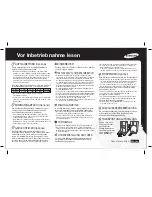
Hints
21
Hints for refrigeration
To help you use your refrigerator correctly, here are
some useful hints:
¥
Cooked food, cold cuts, jelly, etc.:
these should
be well covered and can be stored on any of the
glass shelves.
¥
Fruit & vegetables:
these should be thoroughly
cleaned and placed in the bottom drawer.
¥
Butter & cheese:
these should be placed in
special airtight containers or wrapped in aluminium
foil or polythene bags to keep out as much air as
possible.
¥
Milk bottles:
these should have a top and should
be stored in the bottle rack on the door.
¥
Raw meat (beef, pork, lamb & poultry):
wrap in
polythene bags and place on top of the salad
compartment, this being the coldest spot in the
refrigerator.
Meat can only be stored safely in this way for
one or two days at the most.
Bananas, potatoes, onions and garlic, if not
packed, must not be kept in the refrigerator.
Hints for freezing
To help you make the most of the freezing process,
here are some important hints:
¥
the maximum quantity of food which can be
frozen in 24 hrs. is shown on the rating plate;
¥ the freezing process takes 24 hours. No further
food to be frozen should be added during this
period;
¥ only freeze top quality, fresh and thoroughly
cleaned, foodstuffs;
Unplug the appliance before carrying out
any maintenance operation.
Warning
This appliance contains hydrocarbons in its
cooling unit maintenance and recharging
must therefore only be carried out by
authorised technicians.
Defrosting
Frost is automatically eliminated from the evaporator
of the refrigerator compartment every time the motor
compressor stops, during normal use.
The defrost water drains out through a trough into a
special container at the back of the appliance, over
the motor compressor, where it evaporates.
Hints for storage of frozen food
To obtain the best performance from this appliance,
you should:
¥ make sure that the commercially frozen foodstuffs
were adequately stored by the retailer;
¥ be sure that frozen foodstuffs are transferred from
the foodstore to the freezer in the shortest possible
time;
¥ not open the door frequently or leave it open longer
than absolutely necessary.
¥ Once defrosted, food deteriorates rapidly and
cannot be refrozen.
¥ Do not exceed the storage period indicated by the
food manufacturer.
¥ prepare food in small portions to enable it to be
rapidly and completely frozen and to make it
possible subsequently to thaw only the quantity
required;
¥ wrap up the food in aluminium foil or polythene and
make sure that the packages are airtight;
¥ do not allow fresh, unfrozen food to touch food
which is already frozen, thus avoiding a rise in
temperature of the latter;
¥ lean foods store better and longer than fatty ones;
salt reduces the storage life of food;
¥ water ices, if consumed immediately after removal
from the freezer compartment, can possibly cause
the skin to be freeze burnt;
¥ it is advisable to show the freezing-in date on each
individual pack to enable you to keep tab of the
storage time;
¥
do not put carbonated liquids (fizzy drinks, etc.)
in the freezing compartment as they may burst.
Maintenance
















































